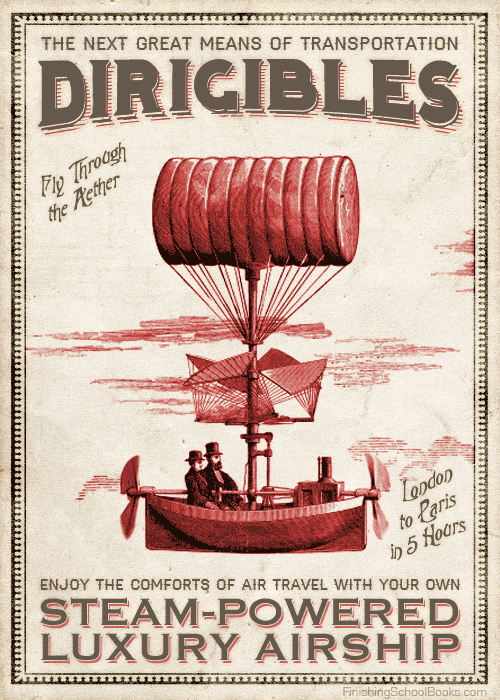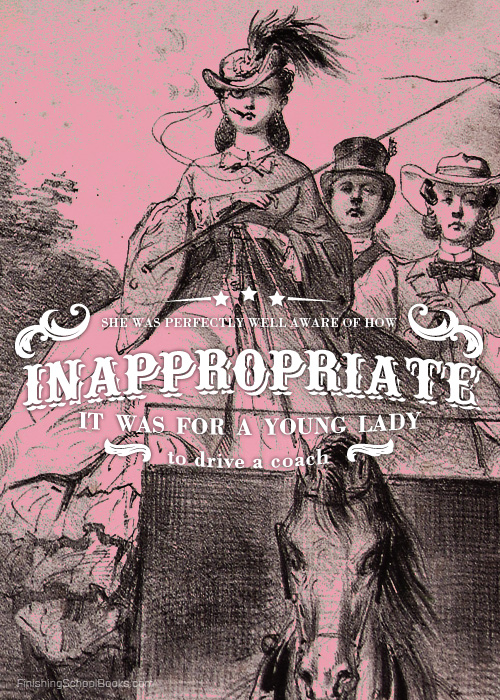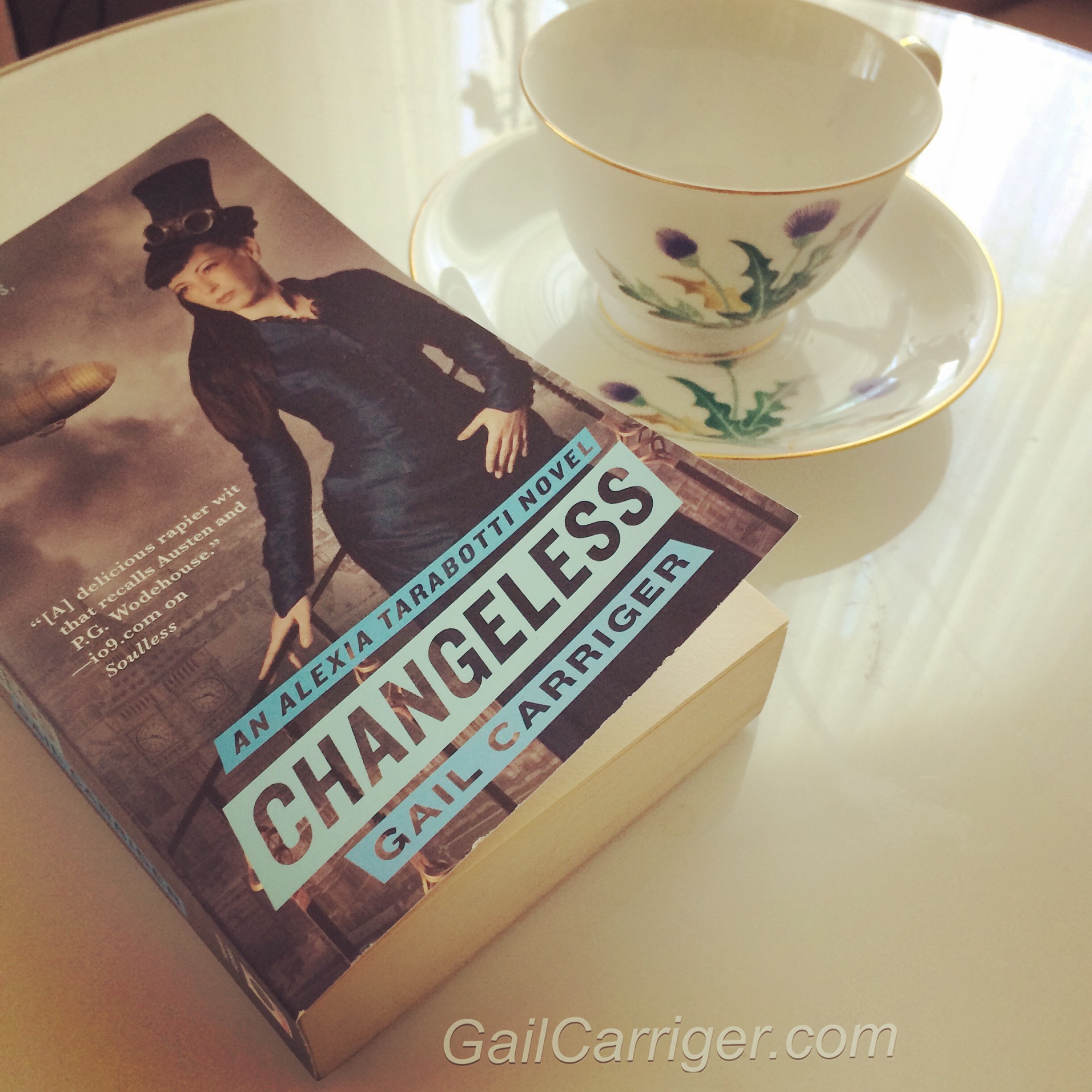So you are writing something set in the Victorian era? How long will it take your characters to get from one place to another?
Below I calculate travel times by horse, train, dirigible, and werewolf.
Gentle Reader, occasionally the curious ask me how I calculate travel times, sooo… I wrote this blog post!

Before writing Changeless in late 2008, I knew there would be travel involved. I began by asking myself:
- How efficient were trains back in 1874?
- How long would it take to get from London to Scotland?
- How might dirigible travel compare to this?
There seemed no simple answer on the net, so I had to draw my own conclusions. And here is how…
Horse Travel Base-line in the Victorian Era
A horse at a forced pace can cover c. 50 miles a day, depending on terrain and weather. A desperate man in very good physical condition can handle the same distance on foot. One horse, one rider could do 200 miles in 24 hours but the horse would probably die. Let’s call that 4 mph normal, and 8.5 mph at a push.
Victorian Train Travel Times
In 1956, the 789-mile Madras-Bombay stretch was done in c. 29 hours by the Madras Express mail carrier (the fastest train on its route). That’s about 27 mph.
My characters in Changeless were traveling north of Glasgow into the Highlands towards Dunblane, I only needed a lose estimate.
It’s 414 miles from London to Glasgow.
So a train of a similar type to the Madras Express would take 16 hours or so. (Modern direct fast trains from London take about 6 hours to get Scotland, meaning we are now over 2x faster than the Victorians.) But no passenger trains of the Victorian Era traveled that quickly within the UK (in my steampunk Victorian time period or the real one). There would be stopovers and passenger pick ups.
So let us, for the sake of argument, double the time it would take to cross England into Scotland from 16 to 32 hours.
After all, this is my universe I get to make adjustments as I see fit.
Victorian Werewolf Travel Times
In my world werewolves in wolf form can move faster than horses at a run, giving them about a 10 mph, but they can only do so at night.
Travel Times in The Parasol Protectorate Series
So from London to Glasgow
- By train: 32 hours, or a day and a half. But given Victorian leisure ideals, it’d probably take more like 2 full days or 48 hours on a fancy sleeper train.
- By horse: 103 hrs or 4 full days, but with resting each night, detours, and other stops, I’d say it’d take a little over 8 days.
- By horse at top speed: 49 hours (switching mounts 2x), lowering that to save the horse to around 60 hours, that’s 2.5 full days, adding in overnights to sleep, a fast messenger would arrive at the end of day 3 with a winded horse.
- By werewolf: 41.5 hours, but he only has darkness, which is about 8 hours each night in September. So it would take him 5 days (and he can’t travel on or around full moon)
- By dirigible: in my world, these are said to move at about half the speed of a train, so it would take 4 days. But they are safer than ground transportation, as neither vampires or werewolves will travel by air, so people opt for them over trains if they have the time. Also they are considered more fashionable.
My estimates are probably a little high given weather and terrain.
The interesting thing is, of course, that the advent of the steam engine would have eliminated a major advantage initially held by werewolves, namely that they could move across the landscape faster than daylight folk.
Coincidence?
Or is this the reason humans are so strongly in favor of increased transport speeds?
Travel Times in The Finishing School Series
Older Technology
My original post concerned London to Glasgow, a little over 400 miles. Then I calculated Exeter to London or thereabouts, which is 200 miles driving in modern times (because there is no direct route, as the crow flies it’s more like 160).
So in 1874 it would take 4 days (96 hrs) get 400 miles by dirigible (c. 4 mph). (Ugh, that’s slow. Why did I write myself into that corner? Oh yes, Alexia had to be on board for a while.)
“Giffard’s first flight took place on September 24, 1852. He traveled almost 17 miles (27 kilometers) from the Paris racecourse to Trappes moving approximately 6 miles per hour (10 kilometers/hour).”
But that was with the wind and untroubled by weather.
My travel tech is more advanced in Sophronia’s 1850s world than in real Victorian 1850s (although still less so than in Alexia’s 1870s).
In the second book of the Finishing School Series, Giffard is flying the first aetherographic dirigible in the spring of 1852 instead of the first working dirigible ever. However, before he came along, floating had to be slower. So I made my Finishing School dirigible fly at a max of 2 mph.
That’s about 80 hours, plus some extras for shilly-shallying to get to London. So . . . 4 days to get from London to Exeter by dirigible in 1852.
It’s amazing how much time it took me to figure this out. But it gave me some good idea on plot and action, and that’s the important bit.
Just goes to show, pay attention in math, you never know when you are going to need it!
Travel Times in The Custard Protocol Series
Newer travel technology of the 1890s
Then of course, I worked on the Custard Protocol Series, which is well into the future, about 20 years after the Alexia books, or the mid 1890s.
So everything has advanced again.
The aetherosphere has been conquered completely as a means of travel, and once people can get inside it, in my universe, it looks and acts in an entirely different manner than Sophronia or Alexia might have guessed.
Since I’m conceptualizing aether as the Victorians scientists did, neither air nor water but some other “elemental phase” (much in the same way light is both particle and wave) I get to have lots of fun with this fantastical part of my world.
Above the atmosphere and beyond!
In the case of more complicated world travel I based my calculations on the approximate speed of trains in the 1890s, combined with those of late pre-WWI steamer ships.
I decided that 1890s dirigible travel inside the aetherosphere is slighter faster than a combo of both, and, of course, you don’t have to transfer at ports. But there is a weight limit to dirigibles, so it’s no good for freight transport, only mortal human passengers. And, of course, the aetherosphere has other issues and concerns in terms of navigation, current predictability, and so forth.
That’s why everyone needs a Percy!
There are beacon ports and other stopovers because refueling is required.
That’s why everyone needs a Quesnel!
Ah travel, these days I’m either thinking about it, calculating it, or engaging in it myself.
More on Victorian Travel
- The Landau Carriage
- The Omnibus Comes to London from Two Nerdy History Girls
- Thomas Cook’S Victorian Tours
Find my books
Directly from Me | Amazon | Kobo | Apple | Bookshop.org | Barnes & Noble | Chapters – !ndigo | Foyles
- Did you miss my latest release announcement? Want more sneak peeks, free goodies, gossip, behind the scenes info? This stuff goes to my Chirrup members, because I love them bestest. Sign up here.
- Not into newsletters? Get only new releases by following Gail on Goodreads, Amazon or BookBub!
BOOK DE JOUR!
Soulless: Parasol Protectorate Book 1
PICK YOUR VENDOR!
Alexia Tarabotti, now Lady Woolsey, awakens in the wee hours of the mid-afternoon to find her husband, who should be decently asleep like any normal werewolf, yelling at the top of his lungs. Then he disappears – leaving her to deal with a regiment of supernatural soldiers encamped on her doorstep, a plethora of exorcised ghosts, and an angry Queen Victoria.
Quote of the Day:
“What is meant by Highland clans? Tribes of Scotch Highlanders, who bore the names, and anciently lives upon the lands, of their respective chieftains, to whom they showed every mark of attachment, and cheerfully she their blood in their defense: these chieftains, in return, bestowed a protection upon their clans, equally founded on gratitude and a sense of their own interest.”
~ Mangnall’s Questions, 1830
Find my books
Direct | Amazon | Kobo | Bookshop.org | B&N | Apple | Foyles | Mcnally Robinson | Angus Robertson
Here’s a printable Downloadable Checklist of ALL my books!
- Did you miss my latest release? Want more sneak peeks, free goodies, gossip, behind the scenes info? This goes to my Chirrup members, because I love them bestest. Sign up here:







